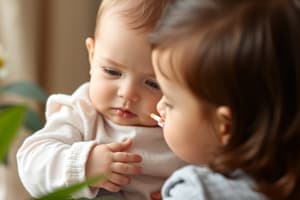Podcast
Questions and Answers
What is the primary effect of myelination on the motor pathways in neonates?
What is the primary effect of myelination on the motor pathways in neonates?
- It prevents any further development of motor functions.
- It leads to a complete cessation of reflexive movements.
- It allows for the disorganized movements to come under increasing control. (correct)
- It enhances their ability to engage in abstract thinking.
At what stage of development does myelination of the motor area of the cerebral cortex begin?
At what stage of development does myelination of the motor area of the cerebral cortex begin?
- At birth.
- At the 4th month of prenatal development. (correct)
- After the age of 2 years.
- During the first year of life.
When does the second growth spurt of brain development occur?
When does the second growth spurt of brain development occur?
- Between the 4th and 5th months of prenatal development.
- After the age of 2 years.
- During the first year of life.
- Between the 25th week of prenatal development and the end of the 2nd year. (correct)
What factor significantly contributes to the growth of the cortex in infants?
What factor significantly contributes to the growth of the cortex in infants?
Which reflex is NOT included in the common reflexes demonstrated by infants?
Which reflex is NOT included in the common reflexes demonstrated by infants?
At what age can infants discriminate their parents' voices?
At what age can infants discriminate their parents' voices?
What significant change occurs in hearing ability at 18 months?
What significant change occurs in hearing ability at 18 months?
What does the prolonged looking time of infants at novel stimuli suggest?
What does the prolonged looking time of infants at novel stimuli suggest?
What is indicated by the concept of critical periods in children's perceptual development?
What is indicated by the concept of critical periods in children's perceptual development?
What type of motor skills involves the use of large muscle groups?
What type of motor skills involves the use of large muscle groups?
Which of the following actions is an example of fine motor skills?
Which of the following actions is an example of fine motor skills?
What developmental pattern describes the progression of motor skills from the head to the feet?
What developmental pattern describes the progression of motor skills from the head to the feet?
Which factor is a crucial aspect of motor development alongside physical maturity?
Which factor is a crucial aspect of motor development alongside physical maturity?
What visual ability is most dramatically improved from birth to 6 months of age?
What visual ability is most dramatically improved from birth to 6 months of age?
What is perceptual constancy?
What is perceptual constancy?
At what age do infants typically begin to respond to depth cues?
At what age do infants typically begin to respond to depth cues?
What significant visual preference do neonates exhibit after 8 hours of contact over 4 days?
What significant visual preference do neonates exhibit after 8 hours of contact over 4 days?
What condition enhances an infant's depth perception, as shown in the visual cliff study?
What condition enhances an infant's depth perception, as shown in the visual cliff study?
What is the approximate visual acuity of children by the age of 3 to 5 years?
What is the approximate visual acuity of children by the age of 3 to 5 years?
At what age do infants typically grasp the concept of shape constancy under certain conditions?
At what age do infants typically grasp the concept of shape constancy under certain conditions?
What happens to infants exposed to a normal backdrop of moderate noise levels by the age of 1 month?
What happens to infants exposed to a normal backdrop of moderate noise levels by the age of 1 month?
At what age can infants typically hold up their heads independently?
At what age can infants typically hold up their heads independently?
What is the primary grasp method used by infants around 3 months of age?
What is the primary grasp method used by infants around 3 months of age?
Which milestone in locomotion is typically achieved by infants at 7 months?
Which milestone in locomotion is typically achieved by infants at 7 months?
What motor skill can be expected of a child at age 2?
What motor skill can be expected of a child at age 2?
Which factor does NOT influence motor development according to the content?
Which factor does NOT influence motor development according to the content?
What are the reflexes that disappear when cortical development occurs?
What are the reflexes that disappear when cortical development occurs?
In the context of motor development, what is the effect of extensive early training according to the Arnold Gesell study?
In the context of motor development, what is the effect of extensive early training according to the Arnold Gesell study?
What is a characteristic of toddlers' locomotion at 12 to 15 months?
What is a characteristic of toddlers' locomotion at 12 to 15 months?
What is the primary function of neurons in the nervous system?
What is the primary function of neurons in the nervous system?
Which part of the brain is responsible for regulating basic functions such as heartbeat and respiration?
Which part of the brain is responsible for regulating basic functions such as heartbeat and respiration?
What is myelination and its significance in the development of the nervous system?
What is myelination and its significance in the development of the nervous system?
Which statement about the human brain's ability to change as a result of experience is true?
Which statement about the human brain's ability to change as a result of experience is true?
What structure of the brain is crucial for balance and motor coordination?
What structure of the brain is crucial for balance and motor coordination?
What does the hierarchical model of development suggest about CNS maturation?
What does the hierarchical model of development suggest about CNS maturation?
What is a significant characteristic of the young brain concerning its response to the environment?
What is a significant characteristic of the young brain concerning its response to the environment?
Which of the following is a consequence of demyelination as seen in multiple sclerosis?
Which of the following is a consequence of demyelination as seen in multiple sclerosis?
Flashcards are hidden until you start studying
Study Notes
Early Development of Hearing and Sensory Coordination
- Infants can discriminate parent’s voices at 3 ½ months old.
- By 18 months, their hearing resembles that of adults.
- Exposure to native language leads to a reduction in the ability to distinguish non-native sounds.
Coordination of the Senses
- Infants link object recognition across different senses.
- Five-month-olds show extended attention to novel stimuli over familiar ones, indicating sensory integration.
Nature and Nurture in Development
- Nature: Neonates possess inherent sensory and perceptual skills, capable of tracking moving objects and preferring specific stimuli.
- Nurture: Critical periods exist in sensory development; lack of stimulation can lead to lasting sensory deficits.
Motor Development Overview
- Physical development involves the growth and refinement of motor skills.
- Gross motor skills include whole-body movements like walking and jumping; fine motor skills involve precise movements with hands and fingers.
- Motor skill development is linked to physical maturity and brain growth.
Structure and Function of the Nervous System
- The nervous system is composed of neurons, which transmit information and vary in size.
- Humans are born with approximately 100 billion neurons.
- Each neuron consists of a cell body, dendrites (receive information), and an axon (transmits information).
Myelination and Brain Development
- Myelin sheath insulates axons, aiding in the speed of neural communication.
- Myelination begins in prenatal development and continues into adolescence.
- Disruption in myelin (as in multiple sclerosis) affects muscle control and neural transmission.
Key Brain Structures
- Medulla: Controls essential functions like heartbeat and respiration.
- Cerebellum: Involved in balance, motor behavior, and coordination.
- Cerebrum: Responsible for learning, memory, thought, and language; develops folds known as fissures as it matures.
Influences on Brain Development
- Environmental stimulation impacts brain growth; connections among neurons increase through experience.
- Stimulation is crucial; lack thereof can hinder motor development and adaptability.
Sensory Development
- Visual Acuity: Newborns are nearsighted, with visual acuity improving rapidly within the first six months.
- Depth Perception: Develops between 6 to 8 months, with studies indicating responses to depth cues at this stage.
Perceptual Constancy
- Infants show perceptual constancy early, recognizing objects as unchanged despite varying sensory inputs.
- Size constancy and shape constancy appear by the end of the first year.
Reflexes in Infants
- Common reflexes include Moro, grasp, sucking, rooting, and stepping.
- Reflex development aids in survival and physical control.
Motor Skill Progression
- Motor development follows specific timelines, starting with head lifting at 4 weeks and culminating in independent walking by 12 to 15 months.
- Children improve grasping skills and coordination as they age, developing the pincer grasp by 9 to 12 months.
Factors Influencing Motor Development
- Motor skills are shaped by individual child factors (physiology, temperament) and environmental influences (family, community).
- Early motor skill training has mixed efficacy, with extreme deprivation leading to motor delays.
Overall Growth Dynamics
- Infants undergo significant brain growth with two critical spurt phases: around the 4th to 5th month of prenatal development and between the 25th week and the end of the second year post-birth.
- Effective development hinges on both biological maturation and rich sensory experiences.
Studying That Suits You
Use AI to generate personalized quizzes and flashcards to suit your learning preferences.



